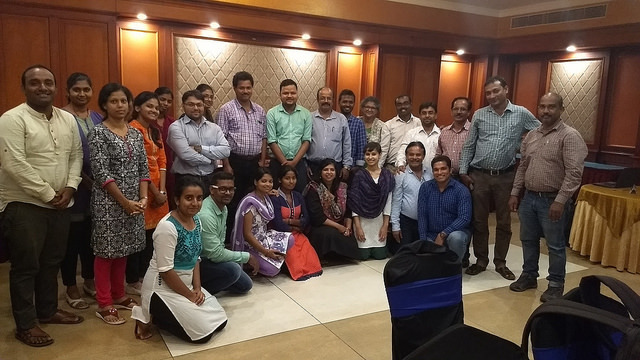Using stories in the classroom: illuminating sessions with Teach for India in Delhi and Bangalore
Posted by Remya Padmadas on November 03, 2017Outreach team member Khyati Datt writes about our recent workshops with Teach For India in Bangalore and Delhi.
StoryWeaver has collaborated with many organisations in order to take stories to more and more children. One such organisation that works with children directly is Teach For India and we conducted a StoryWeaver workshop with the Teach for India fellows in Delhi and Bangalore. We invited fellows from the organisation to spend a few hours with us and brainstorm around ways that stories could be integrated with everyday teaching in the classrooms.
With the fellows coming straight from school, the workshops were shorter than our usual workshops but the fellows were actively engaging with us despite the long tiring day that they’d just had.
The session in Delhi began with a quick round of introductions where the fellows told us their role in the organisation. It was great to see that the participants worked in different verticals of the organisation - there were Program Managers, First year fellows, Content Advisors and TFI alums in the audience. After a brief introduction of Pratham Books and StoryWeaver, we dived into the demo of StoryWeaver and the functions available on the platform.
We discussed with them the various ways that different organisations were using the content on the platform to give the participants ideas on how to combine learning with fun! We also saw videos of teachers and organisations using StoryWeaver with their students and shared our thoughts on whether stories could help make classes more joyful. The fellows then went on to their first task of the session - looking for interesting stories and plugging them in in a lesson plan. While some fellows decided to use the story for Reading Comprehension, others chose to use a STEM book to introduce the children to the concept.
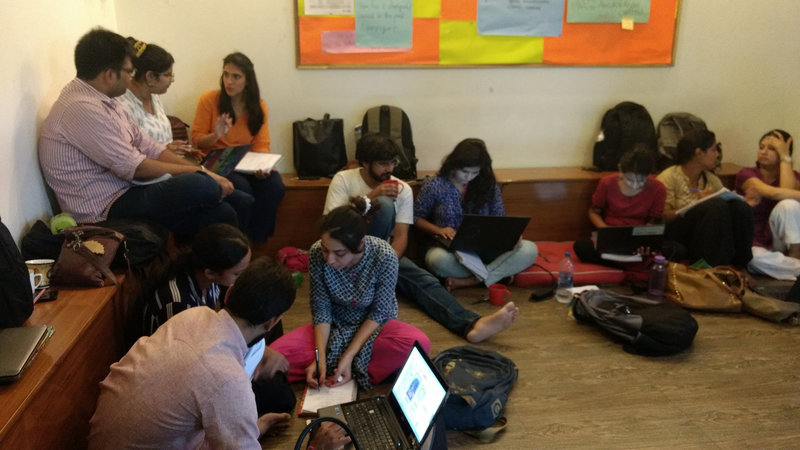
After hearing the thoughts of the participants on what they’d seen so far, we asked them to do the most interesting task of the workshop - creating stories! The fellows saw this as an opportunity to create the kind of stories that they thought would work in their classrooms and added a fun element to their lessons. We received some great stories from the audience, with flying animals and dream schools!
We ended the session with a question - actionable ways through which stories could be used with children. While some fellows were excited to share their takeaways from the session with other fellows, the alums wanted to understand how stories could be used in their context.
We conducted the same workshop with the Teach For India Bangalore fellows. All the participants were in their first year of fellowship and were happy to share their experience in the classrooms and discuss with us ideas on how they could use stories to make children learn in a joyful manner!
Both the workshops gave us an opportunity to interact with people who were working with children directly and we thank Teach For India Delhi and Teach For India Bangalore for arranging the same.
If you are interested in hosting a similar workshop for your organisation, drop us an email on [email protected].
Be the first to comment.Spreading the net to find new writing talent
Posted by Remya Padmadas on May 23, 2018In the last year Pratham Books’ StoryWeaver platform has scaled up its offering of joyful multilingual books for children. One of our content streams headed by Bijal Vachharajani is creating 50 brand new books every year. “It's a tall task, one as gigantic as Hagrid!” shared the Potterhead. “Conversations with Outreach partners told us that we needed more engaging level 1 picture books to take to the youngest children. We also wanted to find new writers to work with.”
The editorial team was wondering how they could reach out to new authors who could write Level 1 picture books that used sound and action, which are always popular with young readers and educators alike. That's when wedecided to reach out to the children's theatre community. After all, who better to collaborate with than professionals who have spent much of their career writing, directing and acting in plays for children?
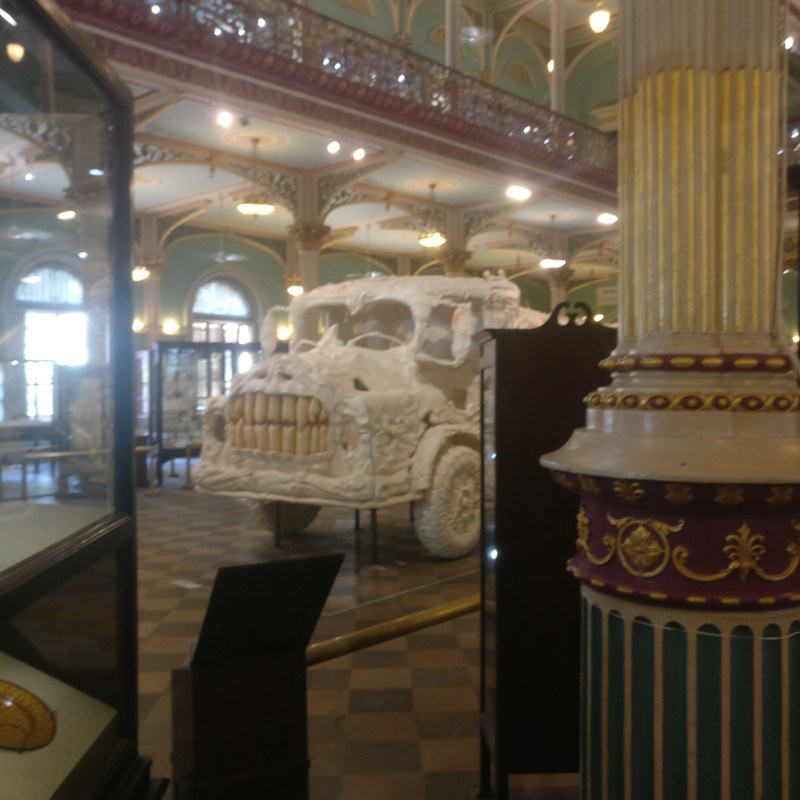
The venue for the workshop was the wonderful Bhau Daji Lad Museum, Mumbai.
Pratham Books Editor Shinibali Mitra Saigal, one of the founders of Kahani Karnival, reached out to her extensive network of writers in theatre. She also stepped in to curate the workshop.
“I think it's important to spread the net when trying to catch new writing talent. By focusing our attention on people with a specialised set of skills, and then guide them to picture book creating, we can make books that use their skills. In this case, it was a strong connection to what children find exciting and a good sense of sound, action, dialogue and dynamic storytelling” said Shinibali who kept in mind diverse skill-sets and an ability to accept feedback and change when choosing particpants. Shinibali’s handpicked group included a perfect blend of people like Sananda, Timira and Preeti who had created plays and scripts in schools for years and who were also very well-versed with picture books.
Authors like Neha Singh and Chatura Rao (winner of the The Hindu Good Books Best Picture Books award 2018) and playwrights like Akshat Nigam who recently won the Hindu best playwright award along with a colleague. Much loved theatre group Gillo Gilehri was represented by Janit and Yashoda. Actor and theatre instructor Lovleen Misra who has a rich background in theatre and television brought her own unique flavour to sessions. Bilingual Shawn Lewis is a strong believer in the idea that sounds rule a script while Shivani Tibrewal who has been teaching children to create scripts and plays loves the idea of whimsy.
Author Chatura Rao was keen to attend the workshop as “Workshops like this help a lot in peer-exchange of ideas.”
Over one-and-a-half days, in the leafy environs of Bhau Daji Lad Museum, a team comprising of Bijal, Shinibali and Assistant Editor Aparna Kapur deconstructed picture books for the participants of the workshop and played games to understand ideas of children's narrative. One of the activities asked the group to split into teams and prioritise what they felt was important in a picture book, using chits of paper that had pre-written statements like ‘A picture is worth a thousand words’ and ‘Picture books should not talk about death, depression and sex’. The teams then had to explain why they chose to order the statements as they had.
Participants talk about writing for children:
Masterclass
The workshop also had the privilege of hosting two amazing picture book creators: prolific author Natasha Sharma and illustrator Tanvi Bhat dropped in to talk to the participants about the finer nuances of writing and illustrating picture books.
“The idea to invite Natasha Sharma for the workshop was very clear. Natasha has written a bunch of books for children which elicit a great deal of excitement and joy. Having attending a number of her sessions, I have seen the queries and the laughter elicited by her books.” said Shinibali. “During her session Natasha took all the participants through the creation of a book. She shared her process and was honest about the things that have worked and have not. She also spoke about how she has evolved as a picture book writer over the years. She stressed on the importance of brevity and cautioned writers against running away with words, and letting the illustrations do the talking. I think that was a very illuminating point for most first-time writers.”
As playwrights, the participants understood the writing process but many of them didn't know what happened to their story once they had written in. Tanvi’s session then looked at the same process of creating books for children but through the lens of an illustrator.
”While making picture books, writers and illustrators are co-creators, so getting an illustrator to talk to the participants was essential. In addition to explaining her own process, Tanvi went into the details of how an illustrator would approach a project in circumstances in which she's involved from the beginning versus one where she receives a complete manuscript, how an illustrator deals with detailed visual notes from the author versus none at all.” Aparna shared.
Tanvi answered the writer’s questions on how involved writers could and should be during this part of book creation, how much of their characters' final look they could imagine, and how the text sometimes has to change once the illustrations are done.
Writing time
Before the workshop began, all the participants were sent a list of themes and ideas to think of potential story ideas around. Post lunch on day 1, the writers shared their story ideas with the group and editors. Their homework for the evening was to take on board the feedback they’d received and write a first draft.
Lovleen Misra’s poetry had the group laughing and sighing in equal measure.
Day two started with each participant taking their first draft to an editor for a one-on-one feedback session. This soon morphed into a freewheeling discussion with small groups sitting under the trees that are spread across Bhau Daji Lad Museum’s courtyard.
Hello Kids!
Sure the writing was great, the coffee was good and the lunch was amazing - but the real highlight of the workshop was when the kids arrived! One hundred feisty, energy-filled kindergarteners from the Sai Baba Path School, Parel brightened up the afternoon with their presence. The kids were there to listen to the authors narrate their ideas which was the real litmus test for their work! Each author took on a group of students, and regaled them with songs, activities and of course, stories!
The workshop wound up with a quick recap of what would happen next, before we bid adieu to the writers, excited about the prospect of fresh stories arriving in our inboxes!
Aparna admitted that her initial apprehensions about the workshop had disappeared. “I was tentative about the workshop because it was the first time we were experimenting with such a format. But at the end of the two days, I was delighted! We'd met a group of people, both smart and humble. They were keen to learn a new skill, and understood what children enjoy, better than most people do.”
“We managed to bring together a bunch of whimsical, creative and slightly off-kilter people who love children and get them to create words\ideas that children will love.” said Shinibali.
We’ve been receiving scripts every day and are confident that we have some real winners on our hands.
Here's a quick look at what happened over the two day workshop.
Be the first to comment.
StoryWeaver’s exciting foray into the East.
Posted by Remya Padmadas on September 26, 2017The Outreach team recently made a big leap towards reaching children in West Bengal and Odisha through two workshops conducted in Kolkata and Bhubaneshwar.
First stop: Kolkata.
We prepped for the workshop, famous Kusum rolls in hand and Kolkata in turn rewarded us with a fantastic turnout. Around 60 participants joined us from 12+ organizations working with children across the education and social sector. People had traveled from Asansol, Purulia, Bardhaman,Chandipur and even Jamshedpur for the workshop! We were amazed by the level of engagement everyone brought to the table throughout the all-day session. One such organization which attended in large numbers was Vikramshila Education Resource Society which works on a range of projects from early childhood education to capacity building from Ladakh in the North to Andaman in the South. One of their team-members raised the point that in West Bengal, if you travel 20km in any direction, the dialect and vocabulary changes. This slipperiness of the language can make teaching and reading a real challenge.
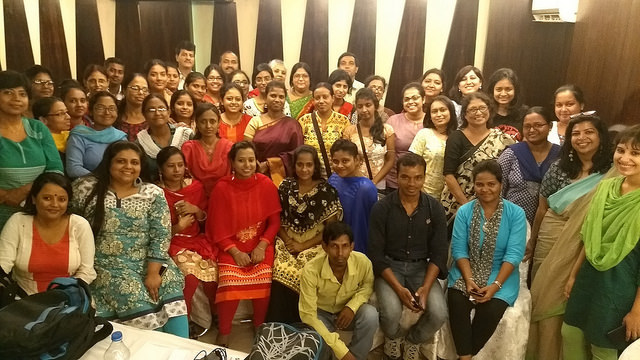
“What happens when the vocabulary of the teacher is not understood by the students and vice versa though both are speaking slight variations of the same language? What happens when students don’t relate to the texts they are reading?”
These very pertinent questions were echoed by many of the organizations in attendance. Fortunately we also had with us an example of a possible solution in the form of two gentlemen from Suchana. Suchana is a 10 year old community group, which works in Birbhum district of West Bengal towards the education of pre-school to class 10 children from Santal and Kora adivasi communities. Their teacher-translators have used the ‘Translate’ functionality of StoryWeaver to great effect to develop supplementary reading materials in Kora and Santali. Currently, 27 Kora books and 19 Santali books, both in Bengali script are on StoryWeaver; all this made possible by the Creative Commons license we follow.
The ensuing discussion was another aspect of our workshops: to bring people doing such good work in different ways into the same space so that they can begin to talk to each other and find areas of synergy.
We jumped into speaking about how Pratham Books came into being and how StoryWeaver was designed to spread the power of stories to all children, particularly those with limited means to access quality books. We delved into our repository of free content from flashcards and spotting books for early readers to our STEM and Life-Skills based books. The books can be used in a variety of ways: getting children to relate things in their science class to real life, using illustrations as speaking or writing prompts, and so on.
We had with us storytellers, teachers, librarians, program managers and content heads. They all put their heads together to visualize how to adapt the LSRW (Listening - Speaking - Reading - Writing) framework and content on StoryWeaver to their programs. Kolkata being the city of adda, we got into a debate of course about what kind of content we can and cannot show our children.
After a demo of how to translate and create your own stories on the platform, the participants got to work. We ended with different groups showcasing stories they had created on the platform during their work-time and we bid adieu with a group picture.
On to Bhubaneshwar we went!
We were greeted by the green, clean city with wide roads and took advantage of the day to plan for the workshop and also to fill our stomachs with ‘dalma’! The next morning at the workshop people began pouring in from diverse organizations like Patang and Nilachal Seva Pratisthan who work in rural areas on programs including literacy for children and employable skill-development training for young adults. A number of organizations working with tribal children and reading and literacy programs were also in attendance such as SELCO, American India Foundation and Bakul Foundation. All of us were gathered in the room with one mission - how do we get children of Odisha access to more books to read in languages they love and understand.
The main challenge that came up during discussion was once again finding adequate content and stories that represented experiences children could actually relate to, in languages that they felt comfortable with. This was where we introduced the audience to our Adi Kahani series- a set of 10 books based on the culture of tribal communities in Odisha, with stories developed and illustrated by local writers and illustrators and published in local tribal languages.
Participants curated and presented lists of stories based on themes they wanted to teach like using ‘Cube Cat Cone Cat’ to teach shapes and dimensions in Math. Some interesting directions were explored during the course of the workshop: Gram Tarang which is involved in skill training and also runs Tarang Vaani, an IVR radio was interested in recording some of our stories and airing them on radio to reach a wider audience! A team member from Sikshasandhan immediately expressed interest in collaborating to make this happen.
The most lively time came during an ice breaker post lunch: we had to learn how to make paper planes out of the resource challenges we’d previously penned down, fly them across the room and pick up a different plane to see if there was any overlap in challenges faced. After all the plane throwing and giggling was over, we settled down into work-time where participants aired the sentiment of common resource challenge and shared the stories they’d translated into Odia and some new creations as well.
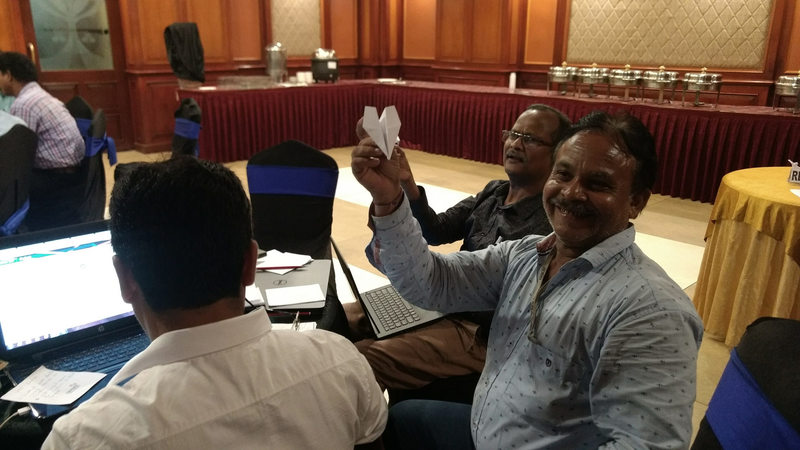
With a last hurrah and a group picture, we said goodbye to Bhubaneshwar. It had been a long, productive week and we were ready to go home and catch some well-deserved rest.
